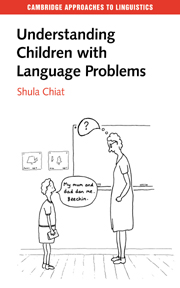Crossref Citations
This Book has been
cited by the following publications. This list is generated based on data provided by Crossref.
Jansonius-Schultheiss, K.
1999.
Handboek Stem– Spraak– Taalpathologie.
p.
1391.
Crosbie, Sharon
and
Dodd, Barbara
2001.
Training auditory discrimination: a single case study.
Child Language Teaching and Therapy,
Vol. 17,
Issue. 3,
p.
173.
Chiat, Shula
2001.
Mapping theories of developmental language impairment: Premises, predictions and evidence.
Language and Cognitive Processes,
Vol. 16,
Issue. 2-3,
p.
113.
Dockrell, Julie E.
and
Lindsay, Geoff
2001.
Children with Specific Speech and Language Difficulties—the teachers' perspective.
Oxford Review of Education,
Vol. 27,
Issue. 3,
p.
369.
Crosbie, Sharon
Dodd, Barbara
and
Howard, David
2002.
Spoken word comprehension in children with SLI: A comparison of three case studies.
Child Language Teaching and Therapy,
Vol. 18,
Issue. 3,
p.
191.
Spooner, Liz
2002.
Addressing expressive language disorder in children who also have severe receptive language disorder: A psycholinguistic approach.
Child Language Teaching and Therapy,
Vol. 18,
Issue. 3,
p.
289.
2002.
Blackwell Handbook of Childhood Cognitive Development.
p.
620.
2003.
Book Reviews.
International Journal of Language & Communication Disorders,
Vol. 38,
Issue. 2,
p.
199.
Seeff-Gabriel, Belinda
2003.
Phonological processing: a platform for assisting second-language learners with English spelling.
Child Language Teaching and Therapy,
Vol. 19,
Issue. 3,
p.
291.
Roy, Penny
and
Chiat, Shula
2004.
A Prosodically Controlled Word and Nonword Repetition Task for 2- to 4-Year-Olds.
Journal of Speech, Language, and Hearing Research,
Vol. 47,
Issue. 1,
p.
223.
Parsons, Stephen
Law, James
and
Gascoigne, Marie
2005.
Teaching receptive vocabulary to children with specific language impairment: a curriculum-based approach.
Child Language Teaching and Therapy,
Vol. 21,
Issue. 1,
p.
39.
Hemsley, Gayle
Holm, Alison
and
Dodd, Barbara
2006.
Diverse but not different: The lexical skills of two primary age bilingual groups in comparison to monolingual peers.
International Journal of Bilingualism,
Vol. 10,
Issue. 4,
p.
453.
Rice, Mabel L.
Redmond, Sean M.
and
Hoffman, Lesa
2006.
Mean Length of Utterance in Children With Specific Language Impairment and in Younger Control Children Shows Concurrent Validity and Stable and Parallel Growth Trajectories.
Journal of Speech, Language, and Hearing Research,
Vol. 49,
Issue. 4,
p.
793.
Ebbels, Susan
2007.
Teaching grammar to school-aged children with specific language impairment using Shape Coding.
Child Language Teaching and Therapy,
Vol. 23,
Issue. 1,
p.
67.
Dodd, Barbara
and
Crosbie, Sharon
2010.
The Wiley‐Blackwell Handbook of Childhood Cognitive Development.
p.
604.
Claessen, Mary
Leitão, Suze
and
Barrett, Nick
2010.
Investigating children's ability to reflect on stored phonological representations: the Silent Deletion of Phonemes Task.
International Journal of Language & Communication Disorders,
Vol. 45,
Issue. 4,
p.
411.
Claessen, Mary
and
Leitão, Suze
2012.
Phonological representations in children with SLI.
Child Language Teaching and Therapy,
Vol. 28,
Issue. 2,
p.
211.
Gatt, Daniela
Grech, Helen
and
Dodd, Barbara
2013.
Early lexical expression in typically developing Maltese children: implications for the identification of language delay.
Clinical Linguistics & Phonetics,
Vol. 27,
Issue. 6-7,
p.
459.
Claessen, Mary
Leitão, Suze
Kane, Robert
and
Williams, Cori
2013.
Phonological processing skills in specific language impairment.
International Journal of Speech-Language Pathology,
Vol. 15,
Issue. 5,
p.
471.
Knowland, Victoria
and
Donlan, Chris
2013.
Educational Neuroscience.
p.
134.



